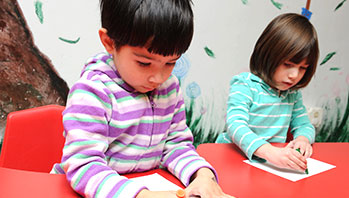- chart paper
- marker
- The Three Little Javelinas (book)
- The Three Little Pigs (book)
- build
- roof
MA Standards:
English Language Arts/Speaking and Listening/SL.PK.MA.1 Participate in collaborative conversations with diverse partners during daily routines and play.
Head Start Outcomes:
Logic and Reasoning/Reasoning and Problem Solving Classifies, compares, and contrasts objects, events, and experiences.
PreK Learning Guidelines:
English Language Arts/Composition 16 Use their own words or illustrations to describe their experiences, tell imaginative stories, or communicate information about a topic of interest.
Draw and Write Together: Comparing Stories

© Commonwealth of Massachusetts, Department of Early Education and Care (Jennifer Waddell photographer). All rights reserved.
ELA Focus Skills: Listening and Speaking, Recall and Retell, Story Comprehension, Vocabulary
Help children compare the two versions of the three little pigs story. Hold up the book The Three Little Pigs by Paul Galdone, and the book The Three Javelinas by Susan Lowell and tell children you are going to have them make a chart that tells things that are the same about the two books and things that are different about the two books.
Make a two-column chart on chart paper. Label one column “Same” and the second column “Different.” Then tell children you will help them make a list of how the stories are the same and different. Start by prompting children. Say, Both stories are about pigs who build houses. That’s one way the stories are the same. Write in the “Same” column “Pigs build houses.”
Help children identify other similarities and differences by asking questions that will help children compare and contrast the stories. Use the illustrations to help children remember the story details. Have children dictate or write their ideas in the correct column of the chart.
- Ask, What is the same and what is different about the materials the pigs use to build their houses?
- Say, Let’s look at the shapes of the brick houses. How is the adobe brick house different from the brick house? (straight/slanted roof; round/rectangle-shaped chimney)
Once the chart is complete, read back what is the same and what is different about the two versions. Encourage children to add to the chart as new ideas come to them.
